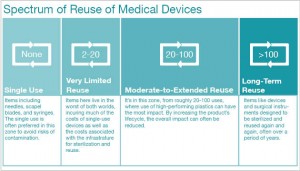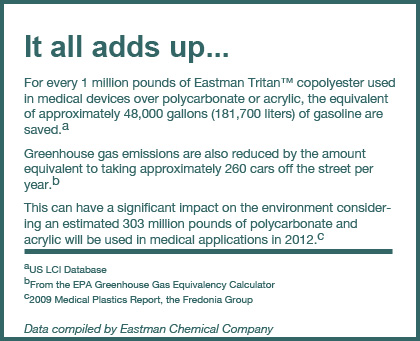Last fall, we started the discussion on sustainability in medical device design, beginning with the most widely accepted definition for sustainable development: “meeting the needs of the present without compromising the ability of future generations to meet their own needs.”
Since medical device design prioritizes patient safety, it’s understandable that the needs of the future have been difficult to manage in this sector. But times are changing. While patient safety will always be a baseline requirement, there are increased calls from regulatory agencies and hospitals to develop sustainable solutions. Societal pressures and corporate responsibility practices also nudge us toward making more sustainable choices. Companies who understand that sustainable medical device solutions often result in cost savings and work to develop them will have an advantage in the marketplace.
In this piece, we’ll focus on materials. We’ll strive to understand the challenges and explore solutions. Which materials make the most sustainable sense and for what applications? How can we create products that balance function with recycling opportunities? Keep in mind, as with most questions in this realm, there is no “best answer” that works for every situation.
Across the spectrum from single to long-term use
If we step back and take a look at a broad range of medical devices, we can get the sense that there’s a continuum that runs from single-use disposables all the way to devices like surgical instruments that are used over and over for years. On the single-use end of the spectrum, the downside from a sustainability perspective is that it’s only used once. The upside is that an infrastructure for sterilizing before reuse isn’t required. While metal is used judiciously on this end of the spectrum (e.g. needles and scalpel blades), there is a much greater use of plastic in single-use devices.
At the opposite end of the spectrum, there are the stainless steel surgical instruments that are used over and over, and are routinely sterilized for reuse. Such stainless steel devices have been around for decades, and remain smart solutions for these applications.
Near the single-use end of the spectrum, imagine devices intended for reuse two or three times. Not surprisingly, there aren’t a lot of devices in this space, as it’s a no-man’s land where we have the worst of both worlds. We’re incurring most of the financial and environmental costs of single-use items and all of the costs required to have an infrastructure for sterilization and preparation for reuse.
For these reasons, it’s helpful to focus on devices targeted for 20 to 100 uses. In this zone, the advantages of reuse can outweigh the costs (both financial and environmental) for maintaining a system for sterilization and reuse. As with the single-use products, plastics are predominant here, too. The best solutions can be the ones that help us move a device from 20 reuses up toward 100 reuses.
 Material Challenges
Material Challenges
Selection of materials for medical devices presents a unique set of challenges. To begin with, we must often use virgin materials for fear of contamination from recycled sources. While plastics from sustainable sources can be a terrific option for non-medical applications, fully biobased plastics don’t stand up well to sterilization and exposure to harsh chemicals encountered in the medical world. They also lack the clarity needed for use in many medical devices. Finally, our solutions need to be based on the understanding that recycling can be compromised when medical devices are contaminated through exposure to bodily fluids.
Material Innovations
Plastics companies have been working hard to develop innovative materials that stand up to all of these challenges, yet improve on sustainability. Obviously, it is the device manufacturer’s ultimate responsibility to determine the suitability of any material for their device. Understanding that, here’s a quick look at two options that should be on our radar:
- Plexiglas® Rnew from Altuglas International is a relatively new, sustainable, bio-based acrylic resin that incorporates high levels of carbon from renewable resources. BPA-free Rnew has great clarity, gamma sterilization resistance, chemical resistance, and impact resistance, qualities that make it a promising alternative in transparent, disposable medical devices for applications including blood collection and separation, fluid management, and certain cardiopulmonary devices.
- Tritan™ copolyester from Eastman Chemical Company is another option with several key attributes which make it an excellent choice for many medical applications. It is free from BPA, Halogen, and Ortho-phthalate. Tritan has outstanding clarity, making it great for applications where practitioners need to see through a device (e.g. bubble detectors), is very durable and able to stand up to sterilization and harsh chemicals, including aggressive disinfectants that can cause polycarbonates and acrylics to crack.
 From a design and manufacturing perspective, Eastman Tritan™ copolyester handles variable wall thicknesses beautifully. It’s also stronger at smaller wall-thicknesses, creating opportunities for using less material without putting wall strength in jeopardy. From a sustainability perspective, creating Eastman Tritan™ copolyester requires lower energy consumption as compared to polycarbonate and acrylic. Its longer life, due to its high degree of durability, results in less waste due to failure.
From a design and manufacturing perspective, Eastman Tritan™ copolyester handles variable wall thicknesses beautifully. It’s also stronger at smaller wall-thicknesses, creating opportunities for using less material without putting wall strength in jeopardy. From a sustainability perspective, creating Eastman Tritan™ copolyester requires lower energy consumption as compared to polycarbonate and acrylic. Its longer life, due to its high degree of durability, results in less waste due to failure.
Balancing it all While innovative plastics can increase a product’s lifespan, we also have to keep in mind what happens at the end of a device’s useful life. In many cases, the highest performing plastics are blends, which aren’t recyclable. The key here is to only use these plastics where necessary and to design for disassembly so more of the product can be recycled. Since contamination can make recycling of medical devices impossible, we should also explore innovative ways to minimize contamination of parts that would otherwise be recyclable.
Of course, all of these trade-offs have to be made in the context of the business model for the device… even if that business model is single-use disposable. With new materials available and on the horizon, the balance point is shifting toward a place that’s more sustainable.
In a future article, we’ll take a look at the world of packaging for medical devices. As you might expect, medical device design serves up unique challenges in that arena as well.






